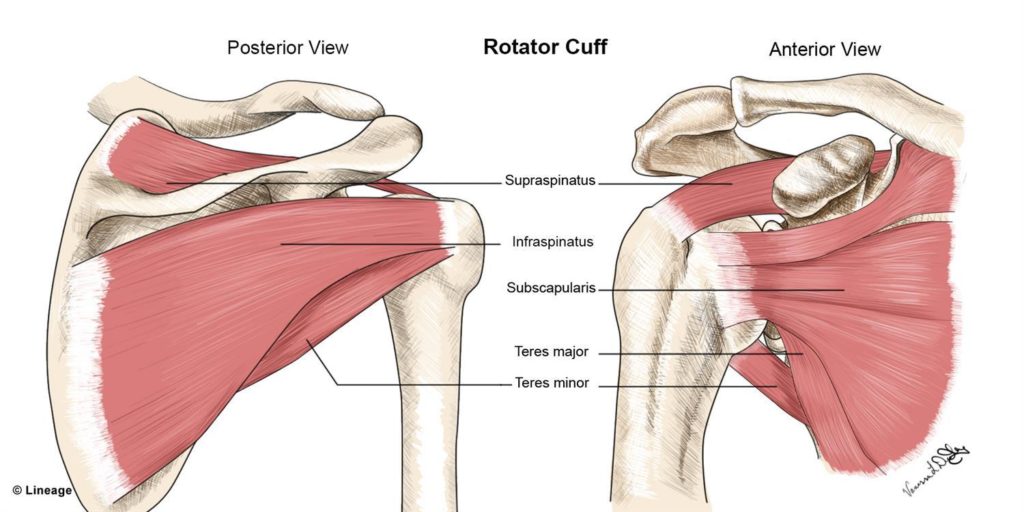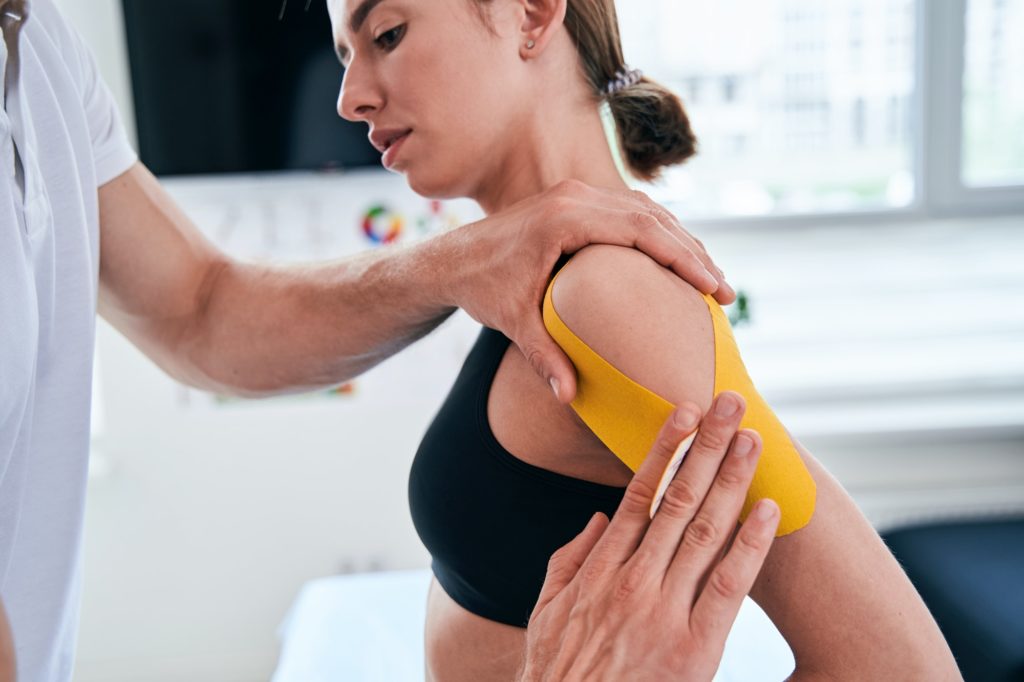If you’ve ever had a shoulder injury, you know exactly how painful, frustrating, and limiting one can be. Yet, most shoulder injuries are preventable. In fact, including rotator cuff exercises in your regular routine can significantly decrease your risk and your chances of spending time on the sidelines, as well as help you bounce back after injury.
In this article, we’re going to explore a bit more about the rotator cuff muscles, as well as shoulder rotator cuff exercises and how to do them. So, let’s dive right in!
What Is the Rotator Cuff?
The rotator cuff is a group of muscles that help hold your shoulder in place and reach your arm up over your head. These muscles include:
- Supraspinatus
- Infraspinatus
- Teres Minor
- And Subscapularis

However, since the shoulder joint gives way to a variety of movements, the rotator cuff is highly susceptible to various injuries and pain. Some of the most common rotator cuff injuries include shoulder impingement, a muscle strain, and a rotator cuff tear. Frequently, these injuries are caused by overuse, as well as weakness in the postural muscles, such as those near and around the shoulder blades.
For example, baseball pitchers are more likely to experience a rotator cuff injury due to the frequent use of these shoulder muscles to throw the ball again and again. At the same time, a rotator cuff injury can occur due to something as simple as falling on your arm.
Either way, both instances result in pain. And usually, this pain won’t go away without some rest and proper treatment.
Immediately following any injury, it’s important to apply an ice wrap and compression to the upper arm or site of injury to help decrease inflammation and swelling. Once the initial pain has begun to subside and the swelling has dissipated, next up, you’ll want to begin rotator cuff exercises. These exercises help restore range of motion, strength, and overall function.
So, let’s discuss rotator cuff exercises in more detail. Why do you need them? What are the benefits? Will you need equipment? And most importantly, how do you do them?

What Are the Benefits of Rotator Cuff Exercises?
Rotator cuff exercises help build strong and resilient shoulders. Maintaining the strength of the shoulder and arm is important since proper mobility and functionality of this joint is necessary for an abundance of basic and everyday tasks.
For example, if you are facing problems with your rotator cuff tendon, you might struggle to reach for an item on the top shelf, drive properly, brush your hair, and much more.
Additionally, another benefit of rotator cuff rehab exercises includes combating age-related changes. As you age, your muscle mass naturally declines. This means you have to work that much harder to maintain it. And this is the importance of regular strength training, no matter whether you’re an athlete or not.
Strengthening these muscles can also prevent the absolute worst-case scenario. For example, many times a rotator cuff tear requires surgery to properly heal. At the same time, this is often reserved for very painful cases. Either way, strengthening these muscles puts you at an advantage since if you do face an injury, you’ll recover faster, and you will also be less likely to face an injury altogether.
Equipment Required
For the following exercises, you will require a doorway you can use and a resistance band. You may want to further invest in multiple resistance bands so that you can level-up accordingly as you get stronger. Alternatively, you can also use a dumbbell since options will be given below. Now, let’s get moving!

How to Perform Rotator Cuff Exercises
The following exercises help strengthen the rotator cuff, as well as create space within the shoulder joint. For each exercise, only go to the point before pain. If pain occurs, stop the exercise and adjust. If pain continues, wait until the pain subsides before trying the exercise again.
1. The Pendulum Exercise
This exercise creates space within the shoulder joint. In particular, it’s very useful for helping with impingement syndrome.
To perform this exercise, stand next to a chair or table. Place your uninjured arm’s hand on the chair or table, and bend forward at the waist. Allow your injured arm to hang. Slowly and gently begin swinging your injured arm in a circular motion. Perform 5-10 reps one way, then 5-10 reps the other way.
Throughout the exercise, ensure you maintain a neutral back (no hunching!). If it’s helpful, you can also hold a weight or a water bottle in your injured arm’s hand to add a bit of “pull” (or as physical therapist’s call it, traction) to the shoulder joint.
2. The Standing Row
The standing row helps support good posture. Poor posture or bad form can quickly lead to a rotator cuff injury. In fact, this is a common problem, contributing to many common Crossfit injuries.
For this exercise, wrap your stretch band around a stable object or doorknob in front of you. Ensure the object or door will not move when you pull on the band and that the band is securely fastened around the chosen object or door.
Stand with your arms straight and the end of the band in each hand. You should start with a bit of tension in the band. Then, slowly and gently pull the band toward you, bending your elbows alongside and past your torso. As you do this, pinch your shoulder blades down and back. Briefly pause once your elbows are just past your torso, then slowly return to the start. Repeat for 10-15 repetitions and 2-3 sets.
For the best results, make sure you don’t shrug your shoulders. Instead, keep them down, back, and relaxed. It may further help to brace your core (or abdominals) to help support your body and prevent your shoulders from rounding forward with the band’s resistance.
To use a dumbbell for this exercise, you’ll want to hold a dumbbell in each hand. Bend forward at the waist and keep your arms dangling straight. Slowly bend your elbows and bring the dumbbells up and toward your belly and chest. Again, it’s important to focus on pinching your shoulder blades together here. Pause, then slowly release.

3. External Rotation Exercise
This is another great exercise that can help strengthen the rotator cuff muscles after injury, as well as prevent future injury from occurring.
For this exercise, stand tall and hold the end of your resistance band in each hand. Bend your elbows to 90-degrees and start with a bit of tension in the band. Keeping your elbows bent and close to your body, slowly pull both of your hands outward. At the same time, focus on pinching your shoulder blades down and back. Pause, then return to the start. Repeat for 10-15 repetitions and 2-3 sets.
Similar to the standing row, it might help to brace your abdominals throughout this exercise to ensure you maintain proper form and posture.
If you choose to use a dumbbell, you will do each arm individually and lie on your side to perform this movement. When doing so, your top arm will be moving outward while you keep your elbow glued to your side.
4. Chest Stretch
The chest stretch can help bring the shoulders back, preventing them from rolling forward. It opens up the chest muscles, lengthening them and preventing tightness.
Find a free doorway. Bend your elbows to shoulder-height and place your forearms on the doorframe. Gently lean forward or step one foot through the door, elongating through your chest. You should feel a gentle stretch through the front of your shoulders and chest. Once you do, hold here for 20-30 seconds, then release. This stretch can be repeated 2-3 times a day.
Did You Know?
The shoulder is the most mobile joint in the human body, making it particularly susceptible to injury.
Frequently Asked Questions About Rotator Cuff Injuries & Exercises
What is the best exercise for a rotator cuff injury?
The best exercise for a rotator cuff injury is actually a combination of many exercises. You’ll want to stretch any tight muscles, as well as strengthen weakened muscles. The four described above offer a great starting point for working out the rotator cuff after injury.
Can a rotator cuff heal on its own?
Yes! However, for a full and optimal recovery, it is always best to seek out the advice of a physical therapist. They can help determine the best treatment plan for you, helping you get back to your regular activities safely and quickly.
How can I heal my rotator cuff faster?
Seeking out help from your doctor or a physical therapist can help you heal faster. They can provide advice, exercises, and more specific to you and your injury. Additionally, you’ll want to avoid anything that causes pain. At the same time, you don’t want to completely immobilize your arm since this can lead to a frozen shoulder.
Should you exercise a torn rotator cuff?
Exercise is one of the best things you can do for a torn rotator cuff. However, what type of exercise you do may depend on where you are at with your recovery. Again, a physical therapist can help you determine the best exercises for your stage of healing.
Can I still workout with a rotator cuff injury?
Absolutely! Focus on using light weights and easing back into shoulder exercises. Alternatively, you can also focus on making gains elsewhere, such as making progress with your lower body or other areas.
Final Thoughts
A rotator cuff injury isn’t exactly a walk in the park. However, what you do following your injury matters. It can make all the difference between whether or not you’re back at your regular activities without pain versus with a nagging injury that just won’t quit.
Use the above rotator cuff tear exercises to help navigate your recovery. Remember, if anything increases pain, stop. Only go to the point before pain. And always follow any advice given to you by your doctor or physical therapist.

